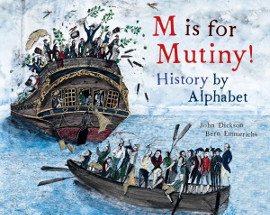M is for mutiny: History by alphabet by John Dickson

Ill. by Bern Emmerichs. Berbay Publishing, 2017. ISBN 9780994384119
(Age: 7+) Recommended. Themes: Australian history. Aboriginal
themes. First Fleet. A different view of Australia's history is
presented in this intriguingly illustrated picture book, with
information to hold readers' attention and drawings that will make
the eye linger on each page.
An alphabet book, the first double page entitled, 'A for
Acknowledgement', is devoted to the first people who lived in this
land. Following is 'B for Banks the Botanist' who accompanied
Captain Cook in his explorations of the southern lands. The text
gives information about this scientist and his place in our history
while the illustrations shows some of the plants he is known for,
adapting the local Aboriginal name for their classification. And 'C
is for Captain Cook', while 'F is for First Fleet', 'M for Mutiny',
'R for Rum Rebellion', 'S for Sheep', so offering few surprises with
information given about known events in Australia's early history.
Where this departs from the expected is the emphasis given on how
the indigenous people were affected by this incursion. So we have 'L
for Land Rights', 'Q for Questionable Acts', 'T for Terra Nulius',
'U for Uproar', and 'Y for Yemmerawanne', while several of the other
pages include information about Australia's Indigenous population.
An alphabet book trying to achieve a 'history by alphabet' is by
necessity very selective, having only 26 headings to use, but this
book has selected a number of events normally not included in
history books, so offering a differing view of our past, one which
readers will recognise alongside learning something new.
Told in a chatty style, each paragraph is enough to engage and
delight while offering snippets of funny information kids love to
read.
References to other events, for example Mabo, gives readers
something more to research, while some themes - Women, Crime and
punishment, Treatment of the Indigenous people - will impel readers
onto to fields beyond this book.
The startling illustrations were developed by painting onto ceramic
tiles which are then photographed. The detail is astounding and
infectiously fascinating, the detail quite extraordinary, making
this a book to pore over. The naive style is reminiscent of early
pottery. The endpapers list all the people of the First Fleet, some
named, most left with a number, underlining the lack of importance
given these people by those who sent them to Australia. In a
classroom, it would be fun to envisage what the students would have
included as their letters.
Fran Knight